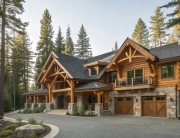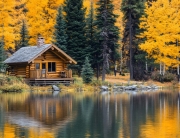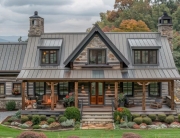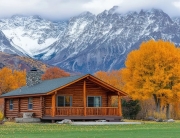Most of us would agree that a fireplace in a log home is just not complete without a wood log mantel above it. The favorite wood for this purpose is pine because it is durable, attractive, affordable, and sustainable. You can choose from many color stains to fit your home décor and place a variety of personal and other objects on a mantel.
When making plans, think about why you want a mantel, its design, material, and cost. Also, think about what you want to put on or above it to make it special.
Why We Like Log Mantels
Mantels accent a fireplace by drawing attention to it and creating a focal point in a room. They are great places to place some of your favorite objects that can vary with the seasons. There are other reasons why we love log mantels, including:
- They bring some of nature into our home
- Log mantels remind us of simpler days and times
- They are great places to display personal items
- Log mantels complement stone and brick fireplaces
- They unify the relationship with the fireplace and room
- Mantels add a touch of beauty and romance
Log mantels and fireplaces tend to make us feel like hanging around longer in a room. They can be customized to fit our tastes, preferences, and home décor.
What Mantels Are Made From
 Fireplace mantels are made from a variety of materials, both natural and manmade. Pine wood is the favorite, and these are other common materials:
Fireplace mantels are made from a variety of materials, both natural and manmade. Pine wood is the favorite, and these are other common materials:
- Hardwoods
- Marble
- Granite
- Brick
- Metal
- Precast Stone
- Composites
- Fiber Board
The material you choose should blend in with the room and house décor. It should also meet your aesthetic needs and your budget. Pine log mantels just seem to go best with log homes and log cabins. The material you choose should be durable and strong enough to support items placed on them. This mantel is a flat timber style made from pine.
“Most of us would agree that a fireplace in a log home is just not complete without a wood log mantel above it.”
Styles of Log Mantels
The type of fireplace mantel depends on the size of your budget, the material, its design, and finish. Shorter mantels look best for smaller or minimalist places. Pine wood log mantels are perfect for log homes and log cabins. The commonly available styles include rustic, traditional, contemporary, modern, Victorian, and custom.
Mantel shapes in log houses are typically thick horizontal rectangles supported by a variety of cradles and shapes. Round log cradles look super with half log mantels. Most homeowners stain the wood a dark hue, but that is a personal choice. Add a clear coat finish to protect the wood and bring out its natural characteristics. In general, simple designs in lengths from 4’ to 8’ go hand-in-hand with log homes and log cabins.
How Half Log Mantels Are Mounted
 Mounting a log mantel during home construction is a relatively simple task. It should be placed high enough above the fireplace opening to avoid getting charred or discolored. Start by installing a 2×4 or 2×6 (depending on the wall framing) horizontally between two studs. If the mantel is long, you may need to install the horizontal support between three or four studs.
Mounting a log mantel during home construction is a relatively simple task. It should be placed high enough above the fireplace opening to avoid getting charred or discolored. Start by installing a 2×4 or 2×6 (depending on the wall framing) horizontally between two studs. If the mantel is long, you may need to install the horizontal support between three or four studs.
The log cradles are secured to the wall framing and horizontal support(s) with screws long enough to hold them securely. Install one cradle and ask someone to hold the second cradle while putting the mantel in place with a level on it. Once leveled, draw a line on the stud to mark the second cradle’s position and secure it with screws.
Check the level again for the cradles and mantel to make sure they are level from front to back and horizontally. If either is a little off, back out the screws and place a thin wood shim under one of the cradles to support it. The last task is to secure the mantel to the cradles with a long screw installed through the bottom side of the cradle. There you have it and a job well done!
Choosing Log Mantel Finishes
The heat from a fireplace is generally not hot enough to damage the stain or clean finish on the wood mantel. Most finishing materials can withstand temperatures up to 200° Fahrenheit. The simple solution is using the same stain and clear coat finishes you use on the log siding or pine paneling walls. The four typical finishes appearances are:
- Flat
- Satin
- Semi-gloss
- Gloss
Oil-based finishes are traditional but can change colors a bit over time. Due to their volatile organic compounds (VOCs) leaking into the air, most people today apply water-based finishing materials. Enjoy your mantel while basking in front of the fireplace.







Recent Comments